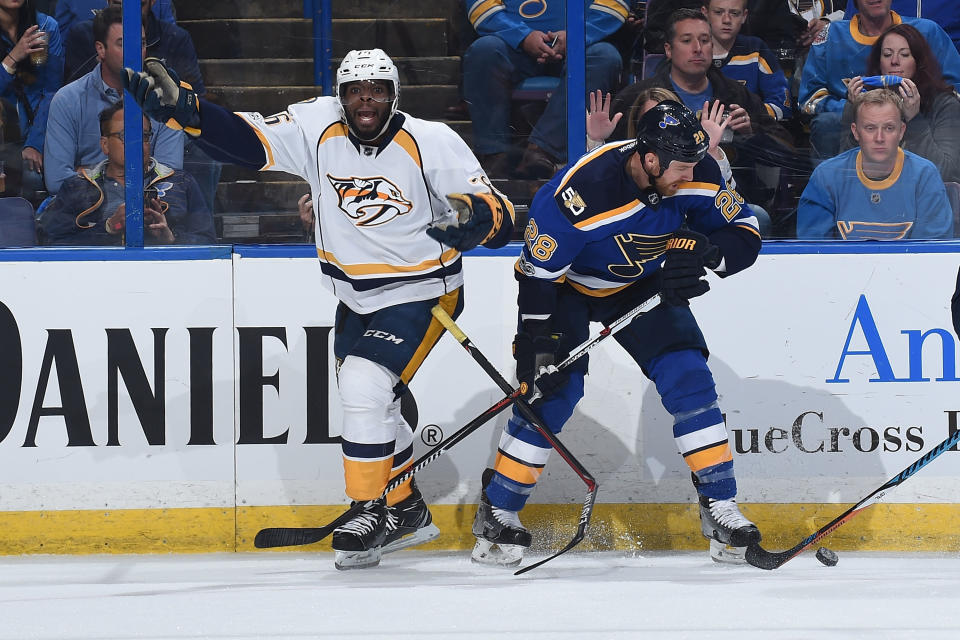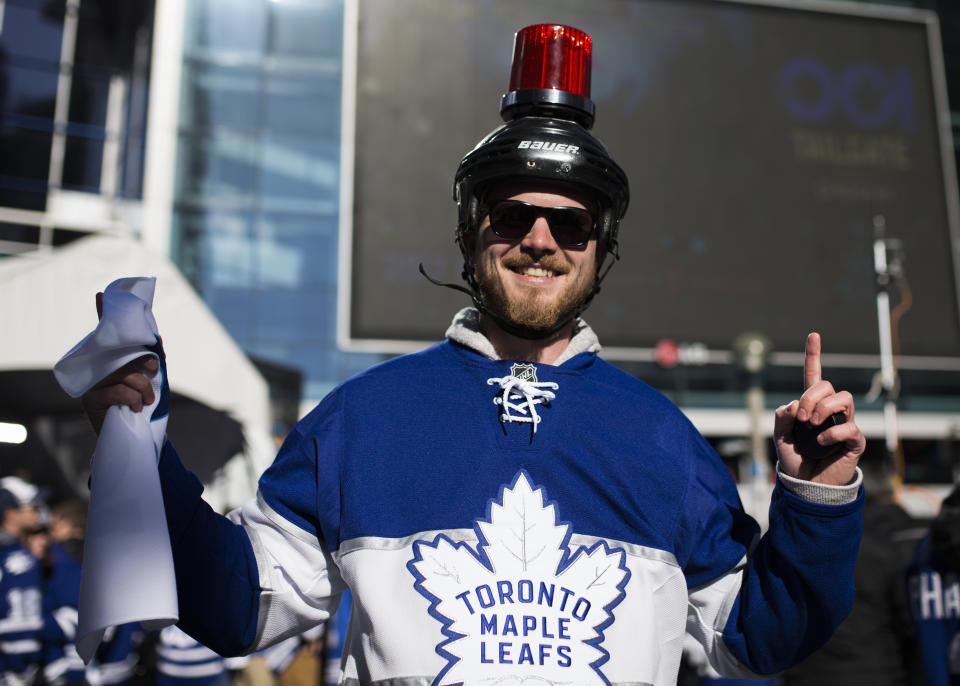Stop crying about NHL slashing calls, let the power plays roll

Kris Versteeg wasn’t around the last time this happened in the NHL, when a tidal wave of penalty calls came crashing down on preseason games to emphasize whatever the League’s cause célèbre was that season. He was in his late teens in 2005-06, toiling in the minor leagues while his older peers attempted to figure out what constituted obstruction during early season games that would feature over 20 combined power plays.
He wasn’t there, but he gets it. He understands the slashing penalties that have created a groundswell of consternation from players, coaches and fans during the 2017-18 exhibition schedule.
“I think it’s necessary, for sure. You see a lot of guys on our team get hurt. I think [the slashing] is unnecessary at times,” said Versteeg to the Calgary Sun. “It’s kind of like the old hooking and holding after the last lockout — once we get used to it I think the pace of the game will settle right in.”
Like most rule changes or reemphasis in the NHL, the catalysts for this slashing crackdown occurred in the previous season: Johnny Gaudreau getting his hand chopped like he was an honorary Skywalker by the Minnesota Wild, and Sidney Crosby giving the world’s worst manicure to Marc Methot of the Ottawa Senators.
There were others, to be sure, as the NHL’s officials called 791 slashing penalties last season, or around 0.64 per game. But the goal isn’t total elimination of these infractions; as per usual with the NHL and player safety, it’s about repeat offenders and reeducation.
“We’re going to eliminate guys who are repeatedly, with force, slashing guys on the fingertips and slashing guys away from the play. When a guy has the puck on his stick, and they’re slashing the hands, we’re going to be taking a look at that closer,” said George Parros, the new head of the NHL’s Department of Player Safety.
“There’s two things we want to eliminate. We want to eliminate repeat offenders in this department and eliminate the same kind of slashes, although we’ve get to define that. Each play is unique. But initially, I’ll be looking at where the slashes take place. If you’re slashing a guy on the elbow pad, I think that would be different than slashing a guy on the finger tips.”
(In the sense that Sidney Crosby probably can’t slash your elbow off, one imagines. Although if he puts his mind to it …)
This crackdown has led to a couple of different strains of hysteria. The first is that fundamentally changing the way slashing is called – based on a League mandate – isn’t fair to the players or the officials. The current officials can’t say anything to the public about these League mandates for penalties, but to hear former referee Paul Stewart tell it, they suck.
“The NHL wants cookie cutter reffing by email mandates, no longer by hockey sense, feel for the game and judgment,” he tweeted.
It’s hard to figure out if the players agree or disagree with this, because depending on the outcome of the game they’ll either tell you it was managed well by the referees or that they “need to call the rulebook” rather than officiating by “hockey sense.” But one imagines that older players, by and large, would rather see referees address slashing with something looser than the zero tolerance they’ve exhibited in the preseason.
“We’ve been swinging our sticks for 20 years. It’s a habit, a frustration. The hard thing is — over the last 10 years — now I can’t grab your free hand. It’s just natural to get waxed,” said Doug Weight, head coach of the New York Islanders, to the NY Post.
The “waxing” is where the NHL is most concerned, according to Stephen Walkom, the head of officiating. Because as obstruction of offensive players has declined, slashing became the preferred means by which to slow an attacker.
“They learned the art of the quick whack on the hand. The whack happens so fast. And as a referee you’re like, ‘Whoa. Did he get him on the hand? Did he get him on the stick?’” he said, via the Toronto Star. “Now we’re giving the benefit of doubt to the player with the puck. So we’re hoping the [defenders] will adapt, and stop [slashing].”
This crackdown serves two purposes: Protecting the players, as much as they can be protected in an inherently violent sport; and seeking to increase goal-scoring by forcing defensive players to play stick on puck, removing a reliable tool from their belts and asking them to find another way to build a wall in front of their zone.
Which brings us to the other strain of hysteria in this preseason, which is that this tidal wave of penalties is going to flood the regular season, creating choppy (hehe) games filled with power plays.
To which I say:
What’s wrong with that?

[Rolls out soapbox]
Goals per NHL game stood at 5.54 last season, which was a six-season high for the League. That’s great, but still nowhere near the pre-trap averages from 20 years ago. The 1993-94 season saw 6.48 goals per game, for example. It also saw 0.90 power-play goals per game, on 5.04 power play opportunities per game. Those percentages in 2016-17? NHL games had 0.57 power-play goals per game on just 2.99 opportunities per game, the lowest number of power plays on average … um, ever? Or at least since Hockey-Reference.com started tabulating them back to 1963.
So, like, call the damn penalties, right?
Especially when you consider this, from an excellent post from Woodblog on the NHL’s lack of goal-scoring and lack of power plays: The NHL has essentially the same five-on-five scoring levels that it did in 1994. Seriously: It was 2.12 goals per team last season, and 2.19 in 1994. Last season was the best even-strength scoring season since 1997. and
Meanwhile, power-play goals per opportunity are actually at a level (0.192) commiserate with the early 1990s, “have actually been rising overall since 1998 and are as high as they were in the early 90’s before the talent dilution of rapid expansion happened.”
Woodguy’s summation?
Think of it: Teams get more shots per minute on the power play; power play opportunities are at an all time low; yet the shots per game are up and the goals per power play are up. I think this is strong evidence that the players are better and coaching is better. All we need the NHL to do is actually call more penalties and we should see a reasonable spike in goals.
When listening to league officials, especially Colin Campbell, there seems to be an underlying idea coming from the league that they don’t want to call too many penalties as it changes the complexion of the game too much and its “not the way we’ve always done things.”
The problem with this line of thinking is that each team earning 4.2-5.5 power play opportunities per game IS “the way we’ve always done things” in the NHL. Today’s dismal 3.1-3.0 ppo/gm is unprecedented in the modern era.
Here’s the deal: Systems and goalies and defensemen are too good in the modern NHL to expect a massive spike in even-strength scoring, bringing it up to, say, 1990’s 2.60 goals per team. (We’re at 2.12 now.) Not without fundamentally changing the game — we’re talking a shift to 4-on-4 hockey or eliminating offside or soccer-sized nets. Those types of changes.
If you want more goals on the board, more 100-point forwards, more celebration highlights, more grist for the fantasy sports mill, then you need to allow offensive players more opportunities to score when they’re best able to, which is on the power play. And the starting point for that is to get power-play opportunities back to respectable levels, despite the hue and cry that the hockey is too choppy or that they interrupt the game flow.
Because calling a massive number of slashing penalties not only benefits that game flow by limiting another form of obstruction, but it also can help on the player safety front while also increasing the number of power-play chances for teams. Which, as was illustrated here, means more goals per game. And this is a good thing, ultimately, for the sport’s popularity. Unless you’re a goalie, which means you’re a weirdo whose opinion shouldn’t matter anyway.
(Granted, in my world, more power plays is just the first step. Gimmie ‘dem two-minute majors and restrictions on the penalty kill. But that’s another column…)
So go ahead, zebras. Raise the arms. Call the slashes. Worst case scenario? We get the power plays the NHL should be granting anyway, given the history. Best case scenario? The players figure out their behavior quickly and this ‘rules emphasis’ saves fingers and opens up the game even more.
Or, alternately: Best case scenario is that only a small percentage of players take advantage of this NHL mandate by dropping their sticks and feigning injury on every love tap.
Worst case: The referees continue this draconian enforcement for two months, forget about it like obstruction, and Johnny Gaudreau has to start wearing those green rubber Hulk Hands under his gloves to save his precious cargo.
—
Greg Wyshynski is a writer for Yahoo Sports. Contact him at puckdaddyblog@yahoo.com or find him on Twitter. His book, TAKE YOUR EYE OFF THE PUCK, is available on Amazon and wherever books are sold.

 Yahoo Sports
Yahoo Sports 

